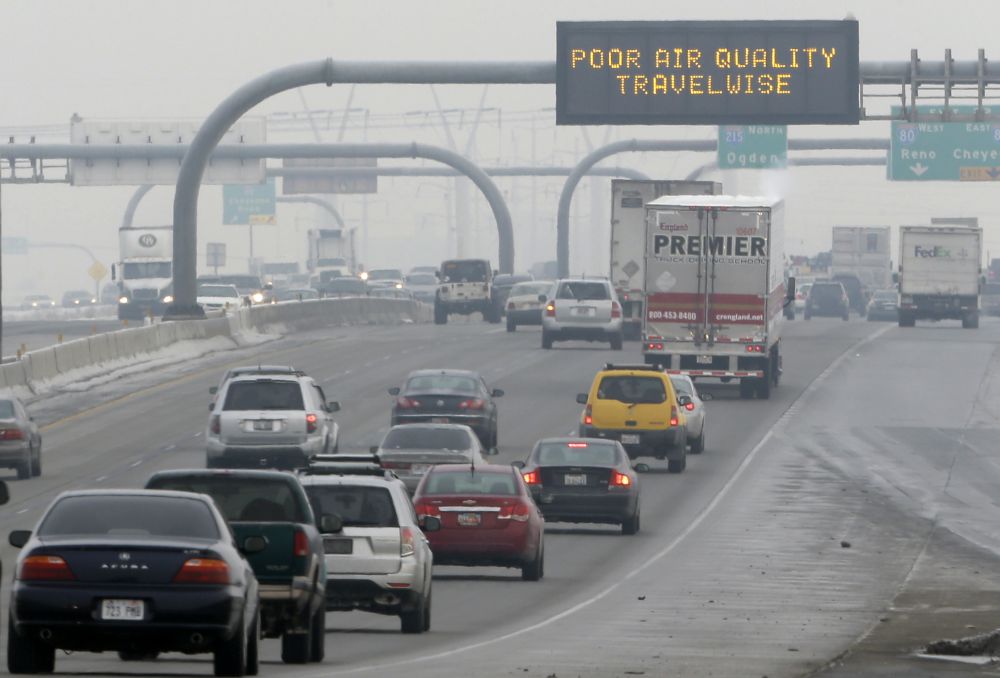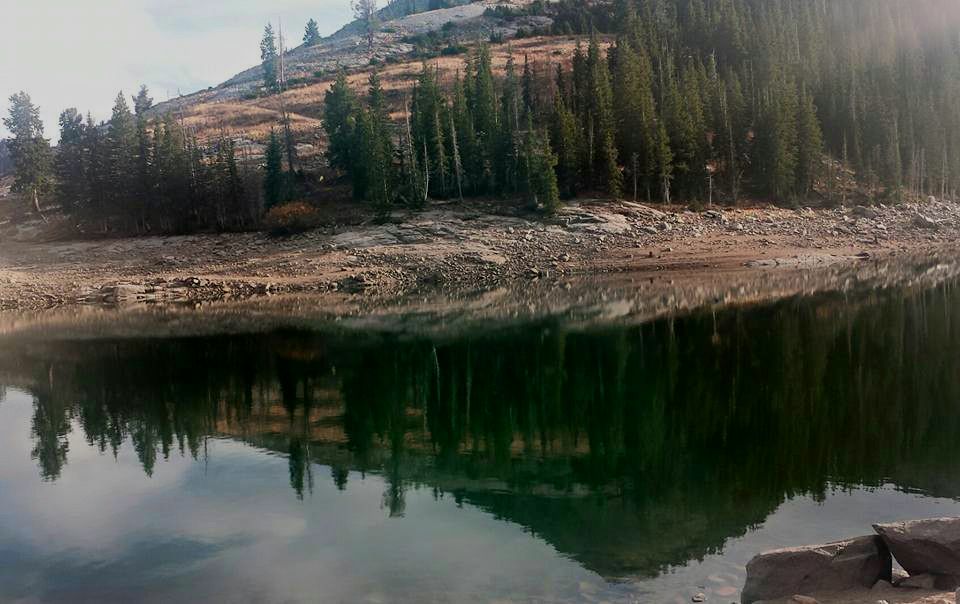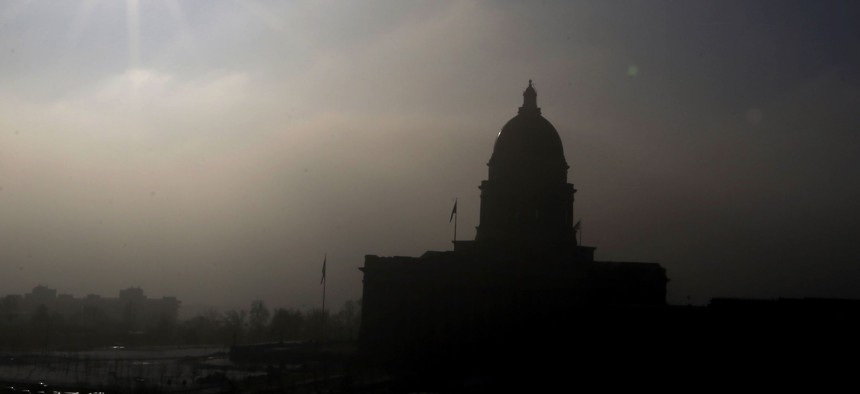Connecting state and local government leaders
Local officials in smoggy Utah are fighting to reduce pollution and move toward solar and other renewable energy sources.
“We’re number one,” workers in Salt Lake City’s sustainability office exclaimed as I was asking one of them how the air quality was last Wednesday.
No. 1 wasn’t a good number. It meant that Salt Lake and other communities in Utah had the worst air pollution in the country on that particular day. An orange haze hung over the Salt Lake Valley, as it often does during winter atmospheric inversions—and during the summertime heat as well.
Peering out his window, Tyler Poulson, sustainability program manager for the city, could barely make out skyscrapers a few blocks away. “You can taste it,” he said of the sickly pollution. Indeed, it was bad enough to make news in the local media.
As a world traveler, I have seen some terrible pollution in places like New Delhi and the Chinese city of Xian. From the first tee at the Delhi Golf Club a few years back, I could barely make out players 200 yards down the fairway, and the first green was invisible.
But that kind of air pollution has largely been eliminated in the United States. Once-filthy places like Los Angeles have good visibility now. One prominent exception is Utah's Salt Lake Valley.
The problem was explained by Salt Lake City Mayor Jackie Biskupski during a meeting of the U.S. Conference of Mayors’ Alliance for a Sustainable Future in late January in Washington, D.C. Her presentation covered both actions the city is taking to combat the air pollution problem and also, in related measures, to address climate change by reducing emission of greenhouse gasses.
Subsequent conversations with Salt Lake City environmental leaders fleshed out the depth of the city’s commitment in both areas—and outlined programs promoting engagement by city employees and residents on the issue. Some of these efforts seemed ripe for adoption by other jurisdictions around the nation.
Salt Lake City’s Bad Air
Biskupski described her city’s environmental plight in stark—and personal—terms.
“In Salt Lake City,” she told her fellow mayors, “we don’t have to argue about whether car emissions and emissions from industry and our homes are harming our atmosphere. We don’t have to ‘wait and see’ the long-term consequences of pollution, we see it every day. For weeks on end every winter, we live in a toxic mix . . . our dreaded inversion.
“My kids Archie and Jack breathe it in, every kid in our city breathes it in, and it’s unacceptable.”
She lamented increased rates of asthma, effects on pregnant mothers, and cited this startling and “true” statistic: “We have as many inhalers as lunch boxes in our city’s schools.”
Biskupski’s predecessor as mayor, Ralph Becker, worked hard to rally the community behind steps needed to reduce air pollution in the Wasatch Front airshed, named for the mountains that flank many of Utah’s major cities.
In 2014, Becker devoted his entire State of the City address to the problem. He detailed not only the health effects of the pollution but also its economic effects, citing the director of the Economic Development Corporation of Utah’s assertion that “the number one reason businesses choose not to come to Utah is because of our bad air quality.” Becker said the University of Utah was losing in the competition for top faculty and researchers for the same reason. And he added that his neighbors had just left Salt Lake City “largely because they did not want to expose their kids to the effect of bad air."
Nearly 60 percent of the airshed’s problem comes from mobile sources, mainly cars and trucks. Pollution from industry and various small sources such as buildings accounts for the rest.
In his speech, and in a recent interview, Becker outlined steps the city has been taking, and those that are still needed. They have included converting city fleet vehicles to lower or eliminate emissions, requiring the same of new taxi vehicles, promoting electric car charging stations, changing building development standards to support solar energy, and adopting planning and zoning changes to encourage biking and walking and more use of public transit.
The city has also built the first “net-zero” public safety building, introduced its first solar farm, and taken other steps to cut pollution. Becker advocated an incentive program to replace high-polluting wood-burning stoves, helping building owners with energy-efficiency upgrades, and upgrading the local airport with the goal of achieving “net zero” status by the mid-2020s.
Becker and Biskupski find some support in their anti-pollution effort from Utah Gov. Gary Herbert, who devoted a section of his 2017 State of the State address to the issue. Herbert noted that the state made progress between 2002 and 2014, cutting total statewide emissions by 30 percent even as population was growing by 600,000. State-ordered investment by utilities and other industrial facilities in emission-control technology has been one major contributor, he noted, and the state and local governments have been investing in transit at a faster pace than other states.
Becker pressed for greater investment in transit, arguing that current systems aren’t providing sufficient service to tempt large numbers of people away from their cars. “Denver, Austin, Dallas, San Jose and many other similar sized cities have a full 1 percent sales tax for transit, which they augment with other public funds,” he said in his 2014 speech. “Here in Utah we have a 0.6 percent tax, and that’s all.”
The state government did not authorize the added tax, but did meet Becker’s plea to give local governments the authority to levy it themselves. A referendum in 2015 asked 17 counties if they wanted to approve the added 0.4 percent. Ten of the counties voted yes, but Salt Lake City narrowly defeated the measure, 51 percent to 49 percent.

That was a setback to cleaner-air efforts. Becker also asked the state to require “Tier 3” low-sulphur gasoline along the Wasatch Front, to make Utah’s air-quality standards tougher than the federal minimums, to increase the state’s lagging gasoline tax to fix roads and discourage excess driving, and to toughen energy efficiency standards for buildings that haven’t been updated since 2006. Becker asked the legislature to authorize local options with these measures if it deemed statewide laws too burdensome. But little has been done to meet his requests.
In late January, as the state legislature convened for its 2017 session, a crowd rallied at the State Capitol to demand more action to clean the air.
And the issue all of a sudden has become embroiled in national politics. On Feb. 5, The Salt Lake Tribune published an editorial worrying that President Trump’s nominee to lead the Environmental Protection Agency, Scott Pruitt, might end the waiver that allows California to set tougher standards for emissions. Autos meeting that standards are sold in Utah and other states. The editorial said:
In a state that prides itself on thin regulation, Utahns never have received much help from state law when it comes to air pollution. Utah legislators, particularly in recent years, have been willing to chip in, like requiring more efficient water heaters or tax incentives for electric cars.
But the real hammer has been the federal Clean Air Act and the Environmental Protection Agency that enforces it. That nearly half-century-old commitment to reducing pollution required dramatic cuts in industrial air pollution and a steady tightening of emissions standards for automobiles.
The editorial also reported that U.S. Rep. Rob Bishop, a Republican whose district spans much of Utah north and east of Salt Lake City, has suggested that the Bureau of Land Management might relax rules capping methane emissions from oil and gas operations.
As chairman of the House Natural Resources Committee, Bishop is in a powerful position to get that done. Methane, like carbon dioxide is a powerful greenhouse gas and helps trap heat in the atmosphere, contributing to global warming.
Bishop isn’t the only Utah politician who’s skeptical of climate regulations. In fact, in 2010, the state’s House of Representatives passed a resolution implying that climate change science is a conspiracy and urging the EPA to stop all carbon dioxide reduction policies and programs.
Climate Change
Salt Lake City has been among U.S. cities that have expressed deep concern about climate change. Although not faced with rising seas that threaten whole neighborhoods in Boston, Miami, New York and other coastal cities, Salt Lake is facing major water supply issues as a result of rising temperatures. And the city has undertaken a wide-ranging effort to reduce its carbon footprint.
The concern responds to a much-noted trend: temperatures in the Salt Lake basin have been rising at twice the global rate over the past 40 years. In the next few decades, some studies suggest, the temperatures could resemble those of southern Arizona.
The trend and consequent concerns made news last April, when the Salt Lake County Health Department convened researchers and political leaders to discuss the effects of climate change in the area.
“We have extended heat waves, we have much higher average temperatures each year, and we are peaking at higher temperatures,” Dr. Royal Delegge, the director of environmental health at the Salt Lake County Health Department, said, according to an April 10 report on KSTU-TV. “The fact is that Utah is warming twice as fast as the world average is, with the changing climate.”
Mayor Biskupski, in her recent speech, focused on the climate change issue. She said it “poses an even greater risk to our city than the dreaded inversion.”
The most expensive and pressing consequence of warming has to do with the water supply along the Wasatch Front. The infrastructure to capture and store water for the driest months was built when snows fell in reliably great quantities in the mountains. This year has been a good year for snow. But the 10-year trend is grim: less and less accumulation, especially at lower elevations.

Salt Lake City has acquired all of the water rights in the Wasatch mountains, Becker explained, and so its Department of Public Utilities provides water for the entire valley. Even if precipitation remains constant, it is falling in different places, and so, said Becker, “we need massive investments in new infrastructure, recalibrating our whole water supply. We’ll need new dams, piping to move the water around, all exceptionally expensive.” One client that will need much more water: the vibrant ski industry in the mountains around Park City, which is already requiring larger supplies to manufacture snow on the slopes. Planning is now under way for the new investments, the cost of which will largely be borne by ratepayers.
The mayor and the city council early this year signed a joint resolution aiming to have 100 percent of Salt Lake City’s energy needs met by renewable sources by 2032, and to reduce the city’s carbon output by 80 percent by 2040.
That is an ambitious goal, and one that could not be done absent cooperation from the region’s main supplier of energy, Rocky Mountain Power. According to the latest report from the company, coal now supplies 62 percent of the area’s energy needs, and natural gas 15 percent. So there is a long way to go.
The mayor found a receptive partner in Rocky Mountain Power President and CEO Cindy Crain, who was also interested in sustainability goals, including much more use of solar power that would take advantage of Utah’s abundant sunshine. The city and the company worked out a franchise agreement allowing close tracking of the city’s goals. “To help RMP, we pledged to become one of the largest subscribers to a new solar farm the utility was building and to encourage other businesses and residents in the city to do the same,” Biskupski told her fellow mayors.
Solar power, along with generating energy from wind and geothermal sources, are priorities, said Poulson, the city’s sustainability manager.
Utah-based companies will do much of the work. Smaller-scale solar work, such as rooftop installations, has been doubling every year since 2010. More than 35,000 panels are now in place. Statewide, some 100 companies employ 3,500 installers, Poulson said.
The state has seen a surge of larger projects as well. Three years ago, said Poulson, Utah had no utility-scale solar installations. But advances in solar technology have reduced costs, and by the end of this year, Utah will boast 3.3 million solar panels. “That’s a great sign that Salt Lake City, Park City and other communities can meet their sustainability goals,” said Poulson.
Salt Lake City has been encouraging owners of commercial buildings to adopt energy efficiency measures. These buildings are responsible for 60 percent of the city’s carbon footprint, according to Biskupski.
“Project Skyline,” now in its third year, recognizes those that have had the greatest success, and the city has just reached an agreement with the city’s Chamber of Commerce to broaden the program.
Biskupski is working on a new ordinance called “Elevate Buildings” that would require buildings with more than 25,000 square feet to benchmark their energy usage and make reductions where possible. Poulson noted that this measure would provide information both to building owners and to prospective tenants information on the relative costs of owning and occupying a building. It will be submitted to the City Council in a few weeks, said Holly Mullen, deputy director of communications for the mayor.
The city has sought to lead by example in the climate change campaign. Its fleet has more than 200 cleaner-burning alternative fuel vehicles, including hybrids and all-electric cars. It has reviewed its public transit situation, hoping to encourage steps to promote usage of a system run by the regional Utah Transit Authority. It has partnered with the University of Utah to gain discounts of up to 25 percent on electric vehicles for various community members, and 130 have taken advantage of the program in its first three months.
The city is benchmarking its own buildings’ energy use, and seeking “net-zero” energy in new buildings or major renovations. “We are proud to have the first Net Zero Public Safety Building in the nation, and are now constructing two net-zero fire stations,” Biskupski said in her recent speech.
And the city is seeking to imbue all of its staff with a climate change sensibility. In 2015, its Sustainability Department, whose website is called SLCGreen, began a year-long Climate Leaders training program for 22 city employees to increase their understanding of global and local climate change and their capacity to communicate about sustainability goals with colleagues and others. The training was offered in nine 90-minute workshops. The department has produced a guide for other cities that might like to replicate its program.
The leaders program requires a big commitment of time and training funds, not possible to repeat for most of the city staff. But the Sustainability Department last spring did launch an employee-wide training program on its web site. The Empower SLC program offers weekly training modules addressing such topics as energy use at home, water conservation, renewable energy, and food. “Empower SLC is designed to motivate behavior change at the individual level in order to reduce pollution, save resources, and enhance Salt Lake City,” according to its website.
Content for the modules is produced by a Park City firm, Sustain3, which has been developing similar training programs for private and public clients.
Sustainability leaders in Salt Lake City also took the initiative to create the Utah Climate Action Network, which brings public, private, non-profit organizations together to work on climate issues. Four climate subgroups address water, public health, energy and transportation in quarterly meetings that begin next month.
“Salt Lake City is noteworthy in the scale of its ambition on climate change,” said Poulson, speaking of the city’s pledge to achieve 100 percent renewable energy over the next 15 years. “We are proud of that commitment. And the time is right from environmental, economic and social policy standpoints.”
Timothy B. Clark is Editor at Large at Government Executive’s Route Fifty.

NEXT STORY: Amid the Opioid Crisis, ‘The Best Ammunition That Public Officials Can Embrace Is Storytelling’




